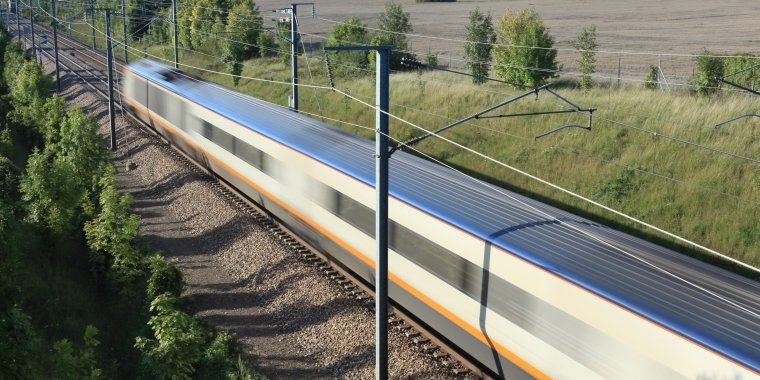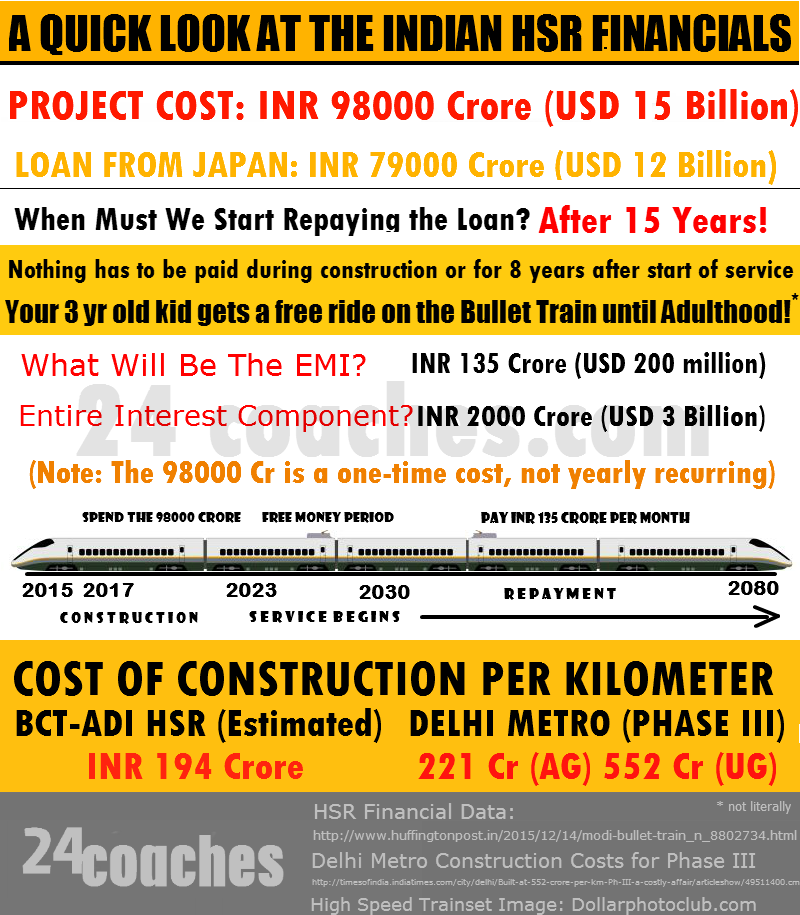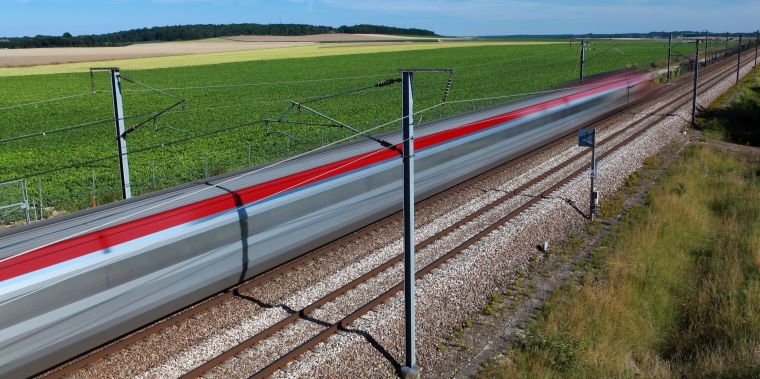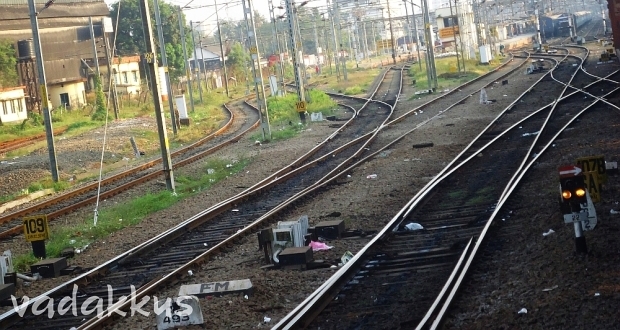On the Financials of the Indian High Speed Rail Project

The most questions everyone seems to have about the Mumbai – Ahmedabad High Speed Rail line project seems to be about its financials, and rightly so. The 98,000 crore or 1 lakh crore (1 Trillion!) Indian Rupees or 15 Billion US Dollars (when rounded off), which the 508 km Ahmedabad- Mumbai High Speed train line is estimated to cost, is an enormous amount of money no matter the numerical system you use to express it. In this chapter, we will try to work out the nitty-gritties of the finances of the project and work out how that amount is well earned and well spent while also examining some other cost-related and economic questions and opposition points to the project. This chapter will be shorter than the others because it includes a big-ass infographic 🙂
The Great Indian High Speed Rail Dream – Part 6
The 98,000 crore, like we saw, is a huge amount of money when looked from an individual’s perspective. But from the perspective of a nation, it is not. India’s GDP for 2014 was USD 2066.9 Billion, or 136.9 lakh crore. The 15 Billion or 1 lakh crore appears puny in front of this, doesn’t it? The cost of building the HSR does not come to even a hundredth (less than 0.01%) of our country’s GDP! Amazing to think that people who happily splurge 2 crore Rupees (USD 300,000) on a 110 sq m (1200 sq ft) apartment, the amount which is much more than their total net worth are so worried about investing 0.007% of our country’s GDP on a project that will propel us into the future!
On the Costs of Building the Indian High-Speed Rail
Let us leave the fancy GDP calculations which people will jump to point out aren’t true performance indicators of a country’s financial performance anyway and have is have a closer look in detail at the financials of the deal we have made with the Japanese, which will bring out the fallacy in the “98,000 crore is too much money for a poor country like India to spend on fancy trains” argument. Please do have a look at how sweet the deal is and how much we will actually be paying for the entire thing
Here is the deal: Japan will provide 79,000 crores out of the 98,000 as a long term loan over 50 years at 0.01% interest with a moratorium (pay back holiday) of 15 years. So we have to fund only 18,000 crores for the project which is in all, small change. And the best thing? It is not our money, and we do not have to pay it back until your 3-year old nephew reaches adulthood! Nice!

But why are the Japanese being so generous towards us? Surely there must be a catch. Of course, there is. We will have to buy all the technology and the trainsets from them. But still, that too is beneficial for us! Let us compare the deal the Japanese have offered us to a real-life analogy most of us are more familiar with. Now, before you finance pundits jump in and say this is not how it works in the real world, please note that this is just a make-believe situational analogy.
Imagine you are a big time real estate guy, planning to buy a huge plot of land in town to build an epic hyper-mall which is going to be the talk of the nation. You approach a bank for a loan. The bank tells you:
“We will help you buy the land and build the mall. We can give you a long-term loan at 5% interest with a 7-year moratorium. But you will have to buy ALL construction and other associated material for the mall from a vendor we nominate, and the mall must be built to our specifications (after consulting with you of course). You can rent out mall space to whoever you want, and you alone will own all the rent you get from the mall. Deal?”
Just like the Japanese, the bank here is not being generous but are just trying to forward the interests of construction companies they have stakes in. Your huge orders will ensure their stock value goes up, they get publicity, more orders in the future and so on. And this is exactly the same reason why Japan, whose economy is stagnating in recent times is being so generous to us; not for the love of us, but for business. But still, the odds of the deal are immensely stacked in our favor. If only we don’t screw up and honor the terms of the contract.
Now that is settled, let us move on to the next question raised by many detractors:
“Why not use the 98,000 crores to improve our present railway network?”
Because we can’t. The loan the Japanese are giving is explicitly for building the high-speed railway line. We cannot use that money for anything else. This is not like us rolling the money dad gave us to pay the electricity bill to recharge our mobile phone data plans. And anyway, it will be a bit hard to find anyone who would give us loans to rebuild our existing railway systems at such ridiculous rates. But that does not matter we are already modernizing our railway network like never before if you haven’t heard about it yet. Oh, and with our own money.
DFC undertakes Mechanized Track Laying for the first time in India. (Pic: NTC machine)http://t.co/Pn0QIM6QAb pic.twitter.com/B1SNq2xwho
— DFCCIL (@dfccil_india) September 23, 2015
The Supposedly Horrendously Expensive Tickets of the Indian HSR
With a famous revolutionary bureaucrat-turned-activist-turned-politician predicting a seat on it will cost Rs.75,000, our Bullet Train ticket cost estimates have reached the Oort’s Cloud. But even the West, HSR ticket prices are often cited to be extremely high. So will our tickets cost their weights in Platinum?
Of course, they won’t. Because forget everything else, such high ticket prices would make no business sense. Most of these astronomical would-be ticket prices are the result of cut-and-dry break-even calculations of “how much should the tickets be priced at, assuming x load factor in y days to make the service profitable etc?” just like how cement bags are priced (production cost+profit=sale price). Such people have no idea on how pricing for transport services work. If operators or carriers were to work out their seat ticket prices strictly looking at profits, nobody would be able to afford any travel on any mode, which is why direct-profitability models are not employed while deciding ticket prices on transportation modes. Also, let us not forget that this will be a publicly-owned public transport undertaking and not a for-profit enterprise, and profit should not be a motive while calculating ticket prices.
For instance, a Boeing 737 aircraft costs close to 100 million USD, 0r 700 crore Rupees. Jet Airways has 75 737s of various types and 75 more on order, in total worth around 1 lakh crore (not counting depreciation). Does a Mumbai – Delhi air ticket cost Rs.75,000? A quick look at the website of the famous Eurostar connecting Paris and London with 500 km of high speed track (same as our first HSR line) shows ticket prices ranging from 45 to 112 Pounds (INR 6600 to 11000) for later dates to up to 180 Pounds (17700 INR) for nearer dates, for our second class (AC Chair Car) equivalent. Holy Shit. But consider this also: A pint of beer in London costs around 3.9 pounds on an average. We don’t pay Rs.400 for a pint in India, do we? We pay Rs.100 at fancy places and Rs.50 at shadier places when no one is watching. Those same economies of scale logic will apply here as well.
"But Bullet Trains will never be profitable!"
Missing the point. They aren't meant to be for-profit enterprises.
Indirect benefits matter.— vadakkus (@vadakkus) December 18, 2015
Of course, making money should be a goal of the HSR, but it should not be the only goal, which will make it lose focus from its actual goals. Those who complain that public transport undertakings are failures because they are not profitable, especially most of today’s professional middle-class startup types, do not understand anything about public transport or profitability (the cement bag types mentioned above). The first aim of transit should never be profit but to provide fast, efficient, comfortable and sustainable solutions to move large masses of people using the least space and energy. Its “profit” is the offset gained through the resulting reduction in fuel bills, pollution, congestion etc and evolution of better living spaces and time and energy utilization. I also would love to see what plans all these founders of all these startups have to make their own enterprises profitable.
The Japanese who conducted the high-speed rail survey have also estimated how much a bullet train ticket from Ahmedabad to Mumbai would cost. Yes, it is much lower than the forex converted Eurostar ticket price. How much? Rs.10000? 8000? 5000? How about Rs.2800? Yes, that is only how much you will be paying for that 2-hour ride, very much affordable for a lot many reading this article!
NB: The entire global airline industry’s profit margin is a wafer-thin 4%, that too in its best year.
Railway Business Models – Dare to Dream Beyond Tickets!
And who said that ticket prices have to be the sole revenue-earning channel? A huge chunk of the Japanese Shinkansen’s revenues come from the land it owns along, under and above the tracks. Japanese rail companies run a lot of diversified businesses from gigantic retail stores to five-star hotels, construction companies, hospitality, merchandising, real estate development and so on, fed and linked by rail operations which are only a part of their businesses but is at the center of it all. This is also why Japanese rail companies are so successful. And it is not just Japan, Zurich’s main station has three levels where trains stop – two of which are underground – and they are only one part of what is called the “Rail City“, a 24-hour open huge shopping complex of over 200 shops, stores and food courts called “Shop Ville” (pics above). Platforms are integrated into the shopping mall! In fact, this is the model followed by most European railway stations.
No large-scale business can sustain itself with only a single revenue source. Imagine Mumbai Central or Bangalore City to be the city’s largest commercial-retail-shopping-entertainment destinations, huge shopping malls where trains also happen to stop, like the Metro station inside Mantri Square mall in Bangalore, but on a much larger scale. Indian Railways owns as much land as the state of Goa, we are sitting on a potential gold mine. The business model of our high-speed rail (and conventional rail also) should be centered at monetizing all that land.

What About the Poor People?
All that has been said until now are just trailers compared to the biggest outcry against the HSR: “Poor people cannot use Bullet Trains! So why build them??” Indeed, why? When so many people in our country have so little, why spend enormous amounts of money, even if it is borrowed, on Bullet Trains? All such fancy investments and stuff in India which are unaffordable by a majority of the population should be stopped! Anything even remotely luxurious – all those cars, restaurants, hotels, malls, shops. Oh, all those is the private sector, you say? Fine. The railways should stop running Rajdhanis, Shatabdis, Durontos or AC coaches and KSRTC and other government STUs must stop running expensive, luxurious Swedish buses when only 10% of our country’s people can afford AC travel! Air India charges 4 hundred thousand Indian Rupees from Delhi to New York in First Class! Who can afford that? Shut it down! Hell, shut down all airlines and planes too since 80% of our population cannot afford them! Stop all those private investors from coming with their money and selling stuff at exorbitant prices! Let us still carry on with the foolish belief of linear change: that we can FIRST “eradicate” poverty and THEN make all that fancy stuff. Some people can afford Mercedeses, some can afford Skodas, many can afford only Marutis, most cannot afford even a Nano. So should we ban luxury cars?
“Why not use that Bullet Train money to lift poor people out of poverty“? Good idea. We should ask the Japanese if we could use the money they are lending us to build high-speed rail to give free handouts to the poor (which won’t reach them anyway) instead. Even if they agree, what do we do when that money runs out and poor people still remain poor? Ask for more money? From other countries as well? Swell idea!
There was a time when India used to be and do exactly all that mentioned above. And that time was also when India was known as the world’s begging bowl. Do we want to go back there?
To those people who are still doubtful: why is it that there are poor people still in the country? Whose making is it that they are poor? Whose economic and political policies have kept them poor all these decades? It is forgivable that Indians are still stuck with socialist mindsets, but what is more noteworthy is that the biggest gang of HSR-opponents consist of Indian-origin intellectual types based in the west, mainly the USA, sitting pretty in their plush capitalist perches but complaining about inequality problems in India. Please stop. Are these elite types panicking that India is losing its “begging bowl” status, that real “emancipation” is underway and they will lose their so-called “status in society” as the arbitrators of everything poor? That their decision to leave India for western shores turns out to be a mistake? The HSR line will do much more good to the Indian people than these entitled pseudo-poor fake intellectuals ever will.

India has undergone sea changes to modernize in almost all other sectors, it is only the railways that are lagging behind. Did these fake intellectuals bemoan the passing of the Ambassador and the Premier Padmini? They why do they want to keep the railways in their current decrepit condition? The elite view railways as a tool to romanticize poverty and will try everything in their power to keep it that way, to keep their nostalgia of that “poor, bygone India” alive in their fancy western lives, which is the real reason for all this “Bullet Train Intolerance“.
Let me reiterate. For sixty years we have been trying to lift people from poverty through socialist means. Has that worked? NO. So let us try something different, to emancipate poorer sections by generating jobs and ways for them to come up in life, instead of giving them handouts. And this high-speed rail project is only a start for that. Let us not forget that Japan was barely recovering from World War 2 when the Shinkansen was launched, which made Japan into the economic powerhouse it is today. Again, for those who are writing off the Indian High-Speed Rail as already a future failure, let us just say that no one can predict anything in surety about ridership, ticket prices or revenues because it is mostly the cement bag economists who calculate those. However, if history is any guide, we can surely say that most naysayers will be proved wrong, as we have seen with many examples right from the Shinkansen to the Delhi Metro. Meanwhile, the Brits are pissed that India is building a real high-speed rail line and the UK is not.
And for those who oppose this project only on political grounds: Go get a life.
The next question is: “How will this one high-speed train line help India achieve all this greatness?” This however, is very valid and is not a myth. If we stop our Bullet Train dreams at the 508 kilometers between Mumbai and Ahmedabad, it will remain what the initial 8 km of the Bangalore Metro is – an expensive showpiece – thereby proving its detractors right. Just this one single high-speed train line will definitely not change India’s fortunes and propel us into the path of awesomeness. For those drastic benefits to be felt in terms of social and economic benefits, our country needs a full network of high-speed lines connecting metros via tier 2 and 3 cities; a comprehensive, pan-India High-Speed Train network supported by robust urban mobility. We will take this forward with a plan for a massive Indian Bullet Train network and its finer details in the next chapters.
More Chapters About High-Speed Rail in India
What are High-Speed Railways or “Bullet Trains”?
Advantages of High-Speed Railways in an Indian Context
Environmental Benefits of High-Speed Rail
How HSR Will Economically Transform India
Shouldn’t We Improve/Run Fast Trains on our Existing Network First?







This article is a piece of amateurish financial analysis.
Go and do a spreadsheet with meaningful projections and you will find that this stupid project will bleed India dry financially. The pay back period of the Bullet Train is 450 years assuming that the Bullet Train runs 24×7 and 100% full every time and that the train tickets are double that of air fares.
Modi does not have any sense to do any analysis but I hope other citizens of our country can do a better analysis and come to a meaningful conclusion.
Excellent article. Well researched. I liked how you openly exposed the Indian mentality, which has ALWAYS remained “Give Us For Free”.
However, I have just one qualm: Why Mumbai-Ahmadabad to begin with? Why not Mumbai-To ANY other city?
Majority of the projects that were meant for Mumbai/Maharashtra have already been whisked away to Gujarat.
The Nhava-Sheva Port modernization project appears to have been shelved, apparently in favor of seaports in Gujarat.
All these developments reek of favoritism. These appear to be attempts at promoting Gujarat, its cities, business hubs and seaports while snatching away Mumbai.
It is high time India improves not just the Railways, but ALSO the sea routes. WHY are Indians confined to land-based transport systems? Why is NO government even attempting to kickstart the sea routes that could connect Gujarat, Maharashtra, Goa on the West Side? Numerous studies have shown that there’s ample possibility to deploy medium-range, high speed transport systems.
Many open-minded people are confused about the aggressive push for the Bullet Train. Mind you… at the complete sacrifice of the Elevated Cargo Corridor that was to be built along the existing Mumbai-Ahmadabad railway track.
Hey,
Great article. In the infographic, the EMI and the interest parts come up to around 20 million and 300 million respectively.
Cheers!